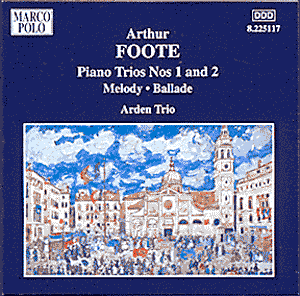
Crotchet
AmazonUK
AmazonUS |
Arthur FOOTE (1853-1937)
|
Arthur William Foote was perhaps the first important American composer to be wholly trained in the United States. He was born in Salem, Massachusetts. His early musical influences came from 'Dwight's Journal of Music' published by music critic, John Sullivan, who presented the most conservative of musical tastes. In it the works of Berlioz, Liszt, and especially Wagner were dismissed for their harmonic complexity, chromaticism and exaggerated expression. In 1867 Foote went to Boston to study harmony with Emery at the New England Conservatory of Music. In 1870 he was accepted at Harvard University where he became Director of the Harvard Glee Club in his final year. It was at Harvard where he studied under John Knowles Paine, a musician thoroughly trained in the German traditions of composition.
After graduating he took organ lessons in Salem from Lang, a former student of Lizst and now a choir director and concert promoter. We owe it to Lang that works by Berlioz (Damnation of Faust), Brahms (German Requiem) and Wagner (Parsifal) were introduced to Boston audiences for the first time. Foote returned to Harvard to continue studies under Paine and receive the first Master of Arts Music degree ever presented at the University. On completion of his studies in 1875, Foote opened a studio for piano teaching in 1875 and this was to become his primary vocation for most of his life.
Visits to Bayreuth and elsewhere broadened his outlook and influenced his writing. Despite continuing to be a church organist in Boston, he became a composer of choral and chamber works, and in particular an influential tone poem, In the Mountains (1886) which was so popular that it was played at the Paris Exposition of 1889. He found his musical vocabulary early in his career and held on to the same style in the 20th Century. He became suspicious of jazz when new ideas were beginning to appear in the 1930s.
Foote realised that he needed to write an extended chamber work to establish his artistic reputation and with this purpose in mind composed the Piano Trio No. 1 in C Minor. The work was composed in a short period of time and after its first performance in 1882 was withdrawn for further revision. This was carried out during a holiday in France in which many of the piano textures were simplified. It was published two years later.
From the beginning we are aware of a well-structured piece: a captivating opening with bright melodic line sweeps through the rippling Allegro con brio. Then follows a bright and spirited Allegro vivace, which shows how accurately the Arden Trio work together. A romantic subject is introduced which then reverts to the spirited opening. A ponderous Adagio molto provides a languid interlude before momentum builds with a strong, highly textured Allegro comodo finale.
The Piano Trio No. 2 in B flat Major comes 25 years after Foote's first Trio. In it he reveals the refinement of a mature artist and expands his harmonic language, yet in it provides thematic material that is less memorable.
A cheerful Allegro giocoso carries a catchy dialogue between violin and piano. A leisurely and poetic Tranquillo holds our attention with a haunting cello theme set against piano accompaniment before the violin joins in with soaring harmony. An Allegro molto provides an energetic final movement with subtlety of instrumental texture.
The Melody for violin and piano was composed in Foote's middle period and is a song for the violin. The piano accompaniment we are told is derived from hymn tunes and parlour songs in equal measure. The violin line hints at Schumann's Ich grolle nicht. A passage based on a rising motif provides a contrast before reverting to the original song theme. The violin (of superb tone, incidentally) is expressively played in this piece.
Of his works for violin and piano Foote thought the Ballade for violin and piano was his best. An influence of Dvorak can be detected in the modal inflections of the melody line, yet it is Foote's characteristic reserve and distinctive piano scoring that dominates. The work opens with a song-inspired melody. This leads to a more energetic middle section before returning to the first theme and ending with a brief coda.
The Arden Trio are excellent musicians, who perform with technical brilliance, using dynamics to good effect so that every nuance is extracted from Foote's music. They were winners of the 1981 Concert Artists Guild Award and between 1987-94 have earned national acclaim with their Saint-Saëns, Ravel, Haydn and Mendelssohn Trio recordings.
The notes on Foote are interesting and are written in English, French and German. The Naxos recording quality of this disc justly matches the expertise of its musicians.
Raymond Walker
See also
ARTHUR FOOTE (18.53-1937) Chamber Music Vol. 1 James Barbagallo (piano) Da Vinci Quartet Lamont School of Music, Denver, Colorado, 27-30 August, 11-14 December 1995 NAXOS AMERICAN CLASSICS 8.559009 [75.58]
ARTHUR FOOTE (18.53-1937) Chamber Music Vol. 2 James Barbagallo (piano) Jeani Muhonen Foster (flute) Da Vinci Quartet Lamont School of Music, Denver, Colorado, 27-30 August, 11-14 December 1995 NAXOS AMERICAN CLASSICS 8.559014 [71.05]